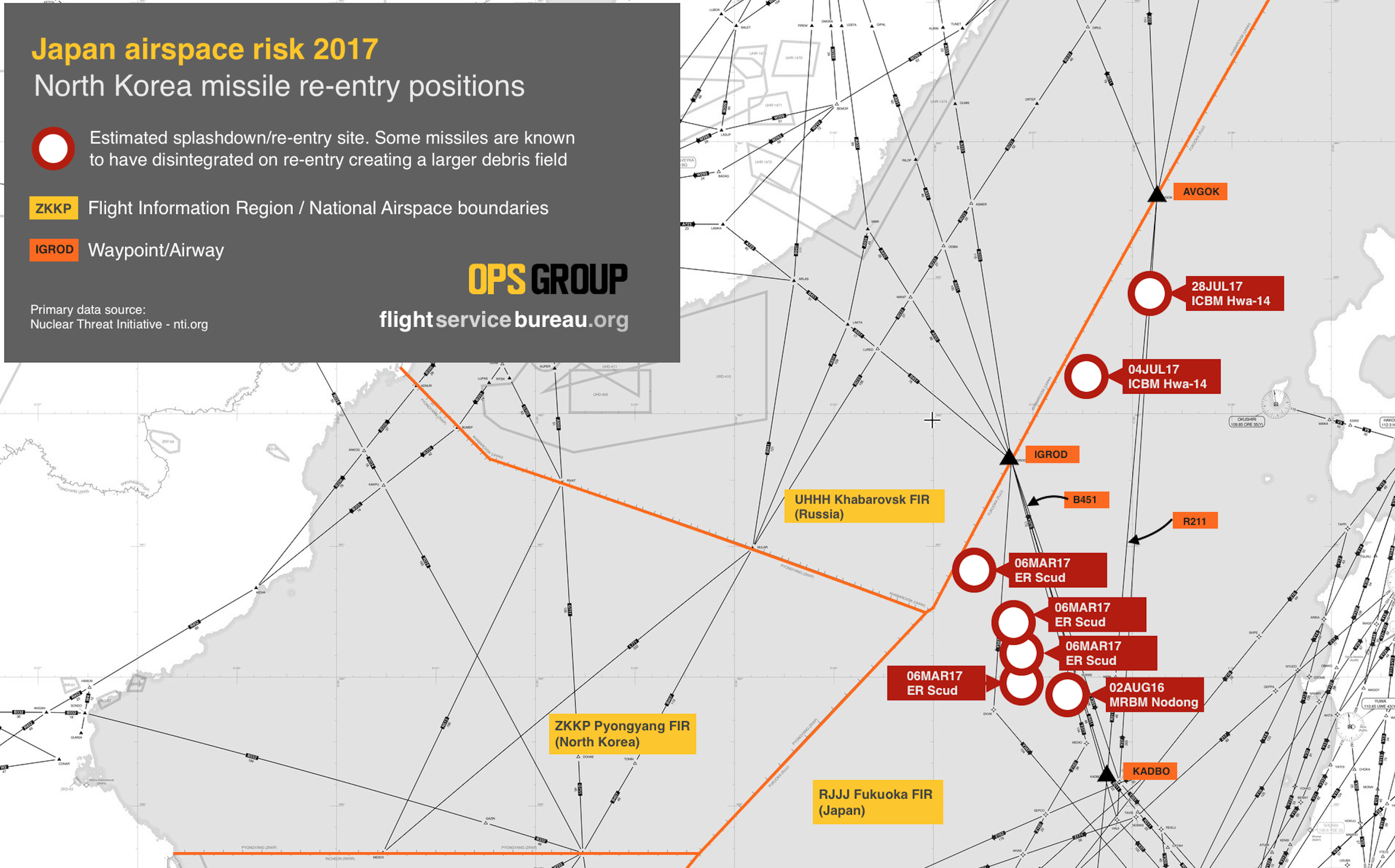Japan
Risk Level: Three - Caution
[ about risk levels ]
The primary risk is from debris from missile re-entries striking aircraft overflying the oceanic part of the ZKKP/Pyongyang FIR over the Sea of Japan. North Korea regularly conducts unannounced missile tests in this area. Consider rerouting to remain over the Japanese landmass or east of it.
The US prohibits flights across all North Korean airspace, including the oceanic part of the ZKKP/Pyongyang FIR over the Sea of Japan. Several other countries have airspace warnings in place which advise caution due to the risk posed by unannounced rocket launches.
Major events:
Oct 2022: North Korea fired a ballistic missile directly over Japan - the first to incur on Japanese airspace since 2017.
2017: North Korea launched two intercontinental ballistic missiles. Both of these landed in the Sea of Japan, well inside the Fukuoka Flight Information Region (Japanese airspace), and significantly, at least one did not re-enter the atmosphere intact – meaning that a debris field of missile fragments passed through the airspace, not just one complete missile.
2015: North Korea gradually stopped notifying ICAO of missile launches, so that aircraft could avoid the launch and splashdown areas.
Read: North Korea Missile Threat, Oct 2022 (OPSGROUP article)

The US prohibits flights across all North Korean airspace, including the oceanic part of the ZKKP/Pyongyang FIR over the Sea of Japan. Several other countries have airspace warnings in place which advise caution due to the risk posed by unannounced rocket launches.
Major events:
Oct 2022: North Korea fired a ballistic missile directly over Japan - the first to incur on Japanese airspace since 2017.
2017: North Korea launched two intercontinental ballistic missiles. Both of these landed in the Sea of Japan, well inside the Fukuoka Flight Information Region (Japanese airspace), and significantly, at least one did not re-enter the atmosphere intact – meaning that a debris field of missile fragments passed through the airspace, not just one complete missile.
2015: North Korea gradually stopped notifying ICAO of missile launches, so that aircraft could avoid the launch and splashdown areas.
Read: North Korea Missile Threat, Oct 2022 (OPSGROUP article)

Current warnings list :
| Source | Reference | Issued | Valid to | |
|---|---|---|---|---|
| USA | SFAR 79 | 07 Sep 2020 | 18 Sep 2028 | |
| OPSGROUP | Note To Members: Japan Missile Risk | 09 Aug 2017 | Ongoing |
Source: USA
Reference: SFAR 79
Issued: 07-Sep-20, valid until: 18 Sep 2028
Plain English: Flights are prohibited in all North Korean airspace, including the oceanic part of the ZKKP/Pyongyang FIR over the Sea of Japan, due to the threat posed by unannounced North Korean missile launches and air defense weapons systems.
This action extends the expiration date of SFAR No. 79, § 91.1615 of title 14 Code of Federal Regulations (CFR), from September 18, 2023, until September 18, 2028. SFAR No. 79 prohibits certain flight operations in the Pyongyang FIR (ZKKP) by all: U.S. air carriers; U.S. commercial operators; persons exercising the privileges of an airman certificate issued by the FAA, except when such persons are operating U.S.-registered aircraft for a foreign air carrier; and operators of U.S.-registered civil aircraft, except when the operator of such aircraft is a foreign air carrier. The FAA finds this action necessary to address significant safety-of-flight risks to U.S. civil aviation associated with the DPRK's military capabilities and activities. These risks include, but are not limited to, extensive unannounced ballistic missile test launches associated with the DPRK's strategic weapons development activities, DPRK air defense and tactical aircraft capabilities that now cover the entire Pyongyang FIR (ZKKP), the DPRK's potential use of electronic warfare (EW) capabilities during periods of heightened tensions, and potential DPRK weapons of mass destruction (WMD) testing, which would likely increase inadvertent risks to civil aviation, both within and potentially beyond the Pyongyang FIR (ZKKP), if it were to occur. Consistent with other recently published flight prohibition SFARs, this action also republishes the approval process and exemption information for this flight prohibition SFAR.
Source: OPSGROUP
Reference: Note To Members: Japan Missile Risk
Issued: 09-Aug-17, valid until: Ongoing
Plain English: Since 2015, North Korea has been test-launching missiles with increasing regularity. The absolute lack of warning, coupled with an emerging picture of a focus area for re-entry, creates a risk to flight operations in the western portion of Japan’s Fukuoka FIR over the Sea of Japan. Consider rerouting to remain over the Japanese landmass or east of it. Check routings carefully for arrivals/departures to Europe from Japan, especially if planning airways which connect with the UHHH/Khabarovsk FIR at waypoints IGROD and AVGOK.
Click the link to open PDF.
